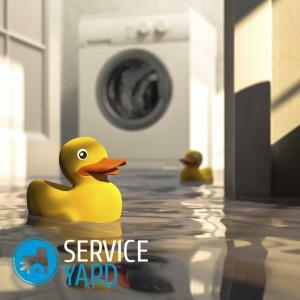
- The main types of breakdowns in which a washing machine flows
- What should I do if the washing machine has flowed?
- Where to start inspection of the breakdown?
- Safety precautions
- Problems with
- hose Leakage due to
- dispenser
door cuff leaks Today the washing machine is one of the most important attributes in every home. It performs an important function - ensures the cleanliness of clothes and linen for each person, besides, saves a lot of precious time. But in return for its usefulness, it requires careful and timely care. If the time does not provide care for the "helper", then it will quickly fail. Repair and services of a specialist at the moment - not an expensive pleasure. Therefore, consultants when buying a washing machine, recommend to use it for its intended purpose and does not refer to the device negligently. It may also be that the reason that the washing machine is flowing from below is the natural wear of the parts. But more about this in the text below.
to the contents ↑The main types of breakdowns in which the washing machine is operated
The market and shops offer a wide range of automatic washing machines of different models and manufacturers. Each model has its advantages and disadvantages. The most common fault is that the washing machine leaks from below. The reasons for the appearance of such a problem can be a huge number.
The most common are:
- malfunction of drain pump;
- defects in the loading tank;
- damage to the drain and filling tube;
- packing gland damage;
- clogging of the washing machine dispenser;
- cracks and holes in the nozzles of the automatic machine;
In order to eliminate these causes of the malfunction, it is necessary to carry out preliminary diagnostics, and then follow certain rules of repair and preventive measures.
to the contents ↑What should I do if the washing machine has flowed?
When the washing machine has started to flow, it is necessary to take measures very quickly and accurately. If the leakage of water is not eliminated in a timely manner, serious problems can subsequently arise not only with the washing household appliance, but also with a floor covering, and possibly with other devices.
Important! The main rule for eliminating such a malfunction is to disconnect the washing machine from power. This will significantly reduce the risk of serious consequences. Immediately shut off the water supply to the automatic washing machine. Only after carrying out this two basic manipulations, it is possible to proceed calmly to the process of inspection of the washing household appliance.
to the contents ↑Where to start inspection of the breakdown?
First of all, you need to determine why the washing machine flows from the bottom? It is necessary to examine the washing machine externally and remember in which mode it worked.
With visual inspection, three leakage points can be identified:
- Dispenser for detergent.
- Drain pipe.
- The cuff of the door of the loading tank.
Safety precautions
Even when inspecting the washing machine, you need to be extremely careful and follow several important rules:
- If water on the floor around the machine is detected, you can not step on it in any case. Since the washing machine can be connected to the mains and you may be electrocuted.
- Empty the remaining water through the drain pipe.
- You need to pull the laundry out of the drum.
Important! If you are not sure of your technical skills, then you should not at all take up repair and removal of breakage. It is recommended to contact the service center for qualified masters. They will be able to correctly determine the cause of the malfunction and provide a qualitative repair of your equipment.
to the contents ↑Problems with the
hose Correctly to determine that the reason that the washing machine flows from below during washing is really a filling hose is very simple. To do this, it is necessary to wrap the tube with paper and carefully look at where a wet spot appeared.
Most often, water leakage occurs at the connection points of hoses with a washing machine. To ensure that the washer does not leak:
- You just need to replace the special gasket, which will provide strength in the connecting places on the hose.
- If even small cuts are found on the hose, they can be patched with a rubber shredder or special glue.
- In case of detection of holes on the tubes, do not try to repair them. It is much easier to buy new ones in the sanitary ware shop, because they quickly wear out due to the high water supply pressure.
Leakage due to the
Dispenser The dispenser is a special compartment in which washing powder and various detergents for washing are added. Determine that the problem is precisely in the dispenser is quite simple. It is enough to take into account one simple rule - the washing machine flows when water is being collected. It is in this case, you can make a firm conclusion that the problem really lies in the malfunction of the dispenser.
It can be damaged due to many different factors:
- thick sediment layer;
- because of the large granules of the powder, the grating of the dispenser was clogged;
- the water head is exceeded.
To eliminate such a malfunction, it is recommended to remove the dispenser from the washing machine and rinse it under running water. After that, install it in place and check the operability of the washing machine.
Important! For efficiency of the result and prevention of a situation when the washing machine flows from below, the water pressure should be normalized.
to contents ↑Door cuff
leaks If the cuff of the loading tank is damaged from the outside, the water will pour from the front of the washing machine. If the cuff is damaged from the inside, the water will pour out from the corresponding side.
Important! Usually the cuff is damaged due to prolonged use or foreign objects( toothpicks, buttons, small toys, coins and some parts of things).
To solve this problem, it is recommended to use a special waterproof super-glue or rubber patch. After their application, it is necessary to turn the cuff so that the damaged part is at the top of the loading hatch. This will ensure the long-term repaired cuff.
Manipulations with super-glue do not differ from the method with a patch. Both methods are ultimately very effective.
Important! Cuff repair can be useless only if the damage is too serious. Then it is recommended to purchase a new cuff.
From this article you learned about all the reasons why a washing machine can run down from below. We hope that you were able to identify the real cause yourself and fix the problem at home. Next - observe the prevention and regular maintenance of your equipment, so that it works properly.



